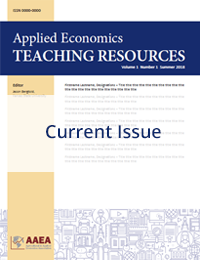Research Article
Awareness and Usage of Extension and Outreach Programs
Julian M. Worley(a), William B. Banks(a), William Secor(a), Benjamin L. Campbella(a)
(a)University of Georgia
JEL Codes: Q16
Keywords: Cooperative extension, outreach programs, extension awareness
Publish Date: January 15, 2024
Abstract
Extension takes many forms, with a common thread to provide scientific information to a diverse audience on a variety of topics. This research examines awareness and use of Extension-related information from different entities (e.g., state Departments of Agriculture, private businesses, and other public entities), overall experience with Extension output from different entities, and use of different types of Cooperative Extension programming (e.g., youth development, food safety, and animal production). Using data from a 2021 survey of around 4,000 U.S. residents, most respondents were aware of or used information from a variety of sources and were not limited to their own state Extension and outreach sources. Depending on the program area, around 30–40 percent of respondents were interested but not using or attending Extension or outreach programming. Several demographic factors were associated with higher or lower awareness and use including age, race, gender, political affiliation, urbanicity, and connection to agriculture. Respondents found information and Extension agents to be somewhat reliable to extremely reliable. Finding ways to motivate
References
Abadi, M. 2018. “Even the US Government Can’t Agree on How to Divide Up the States into Regions.” Business Insider. https://www.businessinsider.com/regions-of-united-states-2018-5?op=1
Borron, A., K. Lamm, C. Darbisi, and N. Randall. 2019. “Social Impact Assessment in the Cooperative Extension System: Revitalizing the Community Capitals Framework in Measurement and Approach.” Journal of International Agricultural and Extension Education 26(2):75–88.
Croft, G. 2019. The U.S. Land-Grant University System: An Overview. Washington DC: Congressional Research Service.
Dobis, E.A., T. Krumel, J. Cromartie, K.L. Conley, A. Sanders, and R. Ortiz. 2021. Rural America at a Glance: 2021 Edition. EIB-230. Washington DC: U.S. Department of Agriculture, Economic Research Service.
Edwin, J., S. McKinley, and B.A. Talbert. 2010. “Cooperative Extension Training Impact on Military Youth and 4-H Youth: The Case of Speak Out for Military Kids.” Journal of Extension 48(1):Article 26.
Greene, W.H. 2012. Econometric Analysis, 7th ed. Upper Saddle River NJ: Prentice-Hall.
Israel, G.D. 1992. “Sampling the Evidence of Extension Program Impact.” No. PEOD5. Gainesville FL: IFAS Extension, University of Florida.
Lusk, J. 2016. “The Evolution of American Agriculture.” Jayson Lusk (blog), June 27. jaysonlusk.com/blog/2016/6/26/the- evolution-of-american-agriculture.
Narine, L.K., A.D. Ali, and P.A. Hill. 2020. “Application of a Three-Phase Needs Assessment Framework to Identify Priority Issue Areas for Extension Programming.” Journal of Extension 58(4):Article 24.
Rader, H.B. 2011. “Extension Is Unpopular-On the Internet.” Journal of Extension 49(6):Article 11.
Stata. n.d. “Margins.” https://www.stata.com/manuals/rmargins.pdf.
U.S. Census Bureau. 2019a. “Age and Sex: 2013–2017.” American Community Survey 5‐Year Estimates. S0101. https://factfinder.census.gov/faces/tableservices/jsf/pages/productview.xhtml?pid=ACS_17_5YR_S0101&prodType=table.
U.S. Census Bureau. 2019b. “Quick Facts: United States.”https://www.census.gov/quickfacts/fact/table/US/PST045219.
U.S. Department of Agriculture, Economic Research Service. 2021. “Agriculture and Its Related Industries Provide 10.3 Percent of U.S. Employment.” https://www.ers.usda.gov/data-products/chart-gallery/gallery/chart-detail/?chartId=58282.
U.S. Department of Agriculture, National Institute of Food and Agriculture. 2014. “Cooperative Extension History.” https://nifa.usda.gov/cooperative-extension-history.
Van Tilburg, E. 1989. “Participation and Persistence in Continuing Lifelong Learning Experiences of the Ohio Cooperative Extension Service: An Investigation Using Expectancy Valence.” Journal of Agricultural Education 30(4):42–46.
Warner, P.D., J.A. Christenson, D.A. Dillman, and P. Salant. 1996. “Public Perception of Extension.” Journal of Extension 34(4).
Yang R.K., R.J. Fetsch, T.M. McBride, and J.C. Benavente. 2009. “Assessing Public Opinion Directly to Keep Current with Changing Community Needs.” Journal of Extension 47(3):Article 6.
Apendix
Articles in this issue
Agribusiness Study Abroad Programs and Their Potential for Fostering a More Inclusive Climate
Timothy A. Delbridge
Awareness and Usage of Extension and Outreach Programs
Julian M. Worley, William B. Banks, William Secor, Benjamin L. Campbell
Does Exam Formatting Affect Grades in Online Agricultural Marketing Courses?
Juan Pachon, Bachir Kassas, John Lai, Gulcan Onel
Training Underrepresented Students via an Interdisciplinary Food Safety Outreach Program
Jeta Rudi-Polloshka, Amanda Lathrop, Karen Cannon and Erin Krier
Market Power in the U.S. Peanut Industry
Yuliya V. Bolotova
To Rebuild or Not to Rebuild When Disaster Hits
Jada M. Thompson, Misti D. Sharp, and Jonathan C. Walton


